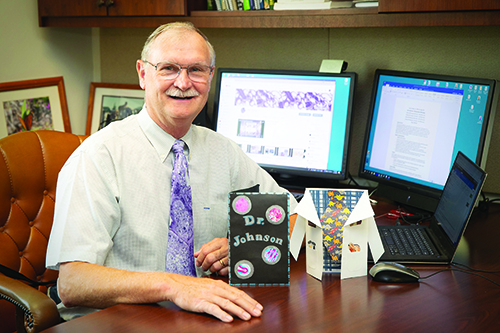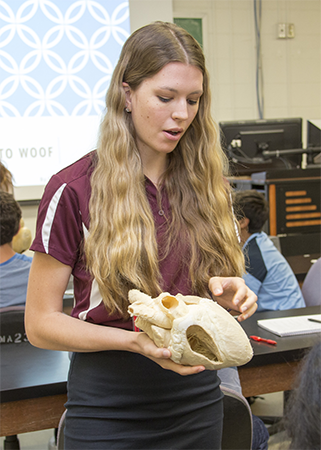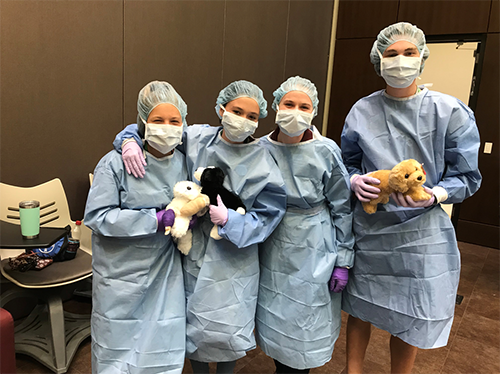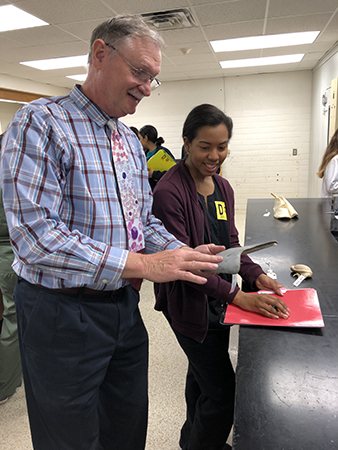PEER Celebrates 20 Years of Service
This year, the Partnership for Environmental Education and Rural Health (PEER) Program at the Texas A&M College of Veterinary Medicine & Biomedical Sciences (CVM) is celebrating 20 years of promoting science education in Texas middle and high schools.

With interactive lessons, exciting guest speakers, and relevant topics, PEER brings the joys of science into classrooms that would not normally have access to high-quality teaching materials. The program operates under the philosophy that by increasing the quality of science education that young students receive, there is a greater chance that they will pursue higher education and STEM careers in the future.
In July 1999, PEER began with a grant from the National Institutes of Health (NIH) with a title that inspired the program’s name, “Environmental and Rural Health Education Partnership,” and kicked off a series of other grants and supplements that would eventually raise more than $8.5 million in extramural federal funds over 20 years.
These grants were made possible by the dedicated work of Dr. Larry Johnson, PEER principle investigator and CVM professor of Veterinary Integrative Biosciences (VIBS), and Dr. William Klemm, director of PEER and VIBS senior professor of neuroscience.
“Larry and I discovered that we both had a passion about K-12 public education, particularly in improving science teaching in rural schools,” Klemm said. “We both were active in research and wanted to be able to share some of that excitement with young people and were encouraged during PEER’s early development by then CVM dean Dr. John Shadduck, who saw the value of science promotion among youth in the pipeline of general and veterinary education.”
Even before PEER began, Johnson did “scientist visits” to his son’s classes, which created a passion for teaching science to younger generations.
He said that because most kids are interested in animals, it’s easy to turn a lesson on animals into a lesson on human, veterinary, or even environmental science. Plus, the realistic, colorful anatomical specimens he takes to classrooms help grab kids’ interests, as well.

Today, PEER supports STEM education in middle and high schools in all 50 states. By providing hundreds of free teaching resources online, sending scientists and student fellows to schools across Texas, and hosting teacher workshops, PEER has even managed to reach students all over the world.
The success of PEER has resulted from efforts of a large team that includes Texas A&M research, teaching, and clinical faculty, public school teachers on PEER staff, PEER website and general staff, undergraduate, graduate, and veterinary students, veterinary technicians, and schools and teachers throughout the US.
Information on the website alone, peer.tamu.edu, is downloaded by 2,000 teachers each year, impacting 250,000 K-12 students.
After PEER received the first grant, which funded K-12 programs in environmental health science, Johnson applied for and received a second, seven-year grant from the NIH, which required PEER to also include math, English, and social studies in its curriculum.
“We hired a teacher to make sure we addressed teaching standards required to be taught in schools and a professional child story author who wrote stories about how middle school kids traveled in time,” Johnson said. “In the story, they traveled back to the building of King Tut’s tomb but someone got sick, so they had to investigate the routes of exposure—is it ingestion, inhalation, injection, or skin contact? Then, they would come up with a solution using math and science and express it using English skills in a social studies setting.”
This story, “Tut’s Revenge,” was joined by five other time travel adventure stories that incorporated all of those themes and more in the school subject integrated curriculum.
Soon after, PEER received two National Science Foundation (NSF) grants that funded public school presentations by Texas A&M graduate students. By working with other colleges at Texas A&M, Johnson and Klemm recruited students from all STEM areas who were interested in sharing their enthusiasm and interests in math and science with K-12 students.
“We had students from all over the university—engineering, math, physics, agriculture, the CVM, and more,” Klemm said. “The grad students made weekly visits and presentations in their assigned schools in the Brazos Valley, served as content consultants to teachers, and developed lesson plans, many of which are still available on our website.”

Over the past 20 years, PEER has also held teacher professional-development workshops across Texas to help middle school teachers stay current on scientific advancements and aware of PEER resources; PEER has offered workshops in locations ranging from El Paso to Mount Pleasant and from Amarillo to McAllen.
“Teachers use these to gain continuing education credits and upgrade their content knowledge,” Klemm said. “In Texas, middle-school science teachers are not required to have been a science major in college. We think that many of them need our help, so we do what we can.”
Part of the money supporting these workshops comes from PEER’s most recent NIH grant, awarded in 2018 to support the development of an app for teachers and students to use for accessing PEER teaching materials related to one health that also cover knowledge standards teachers must transmit to their students.
It also supports additional teacher workshops, which present a great opportunity for PEER to gather input for developing the app and to show teachers how the app can best be used in their classrooms once it’s fully-functional.
“As we present the latest models (of the app), we get feedback from the teachers to improve them,” Johnson said. “The teachers are required to teach specific topics, such as how to use equipment or rationalize a problem. We present our ‘one health’ learning materials in a way that enables the teacher to address those standards.”
The app’s student-centered format empowers students to select their own learning activities and move at their own pace, creating a new motivation for learning, according to Klemm.

“We are excited by this novel initiative and our just-completed first teacher workshop indicates that teachers are going to like this new student-centered approach,” he said.
In his 20 years with PEER, Johnson has spoken to 35,000 kids in their schools and has been awarded two Texas A&M Association of Former Students (AFS) Distinguished Achievement Awards for teaching and outreach and the Texas A&M Bush Excellence Award for faculty in public service.
Johnson plans to move into retirement within the next couple of years but still finds time to teach students all over Texas about the joys of science and to use veterinary medicine to encourage them to learn about their own health.
Given that the PEER program just began the second year of a five-year $1.25 million SEPA project funded by the National Institute of General Medical Sciences within the NIH, Johnson will leave PEER with two years of funds after his retirement.
He has no doubt that PEER will continue as a strong source of outreach for the CVM after he leaves, especially because of the many other CVM faculty members involved in PEER, including Dr. Christine Budke, professor and VIBS associate department head.
“PEER is a wonderful program and I hope that it will continue to have a positive impact on future generations,” Budke said. “I enjoy working with a group of people who are dedicated to encouraging future generations to pursue careers in STEM fields. While creating curricula for adult learners is rewarding, there is something special about introducing middle school students to the joys of science.”
###
For more information about the Texas A&M College of Veterinary Medicine & Biomedical Sciences, please visit our website at vetmed.tamu.edu or join us on Facebook, Instagram, and Twitter.
Contact Information: Jennifer Gauntt, Interim Director of CVM Communications, Texas A&M College of Veterinary Medicine & Biomedical Science; jgauntt@cvm.tamu.edu; 979-862-4216


